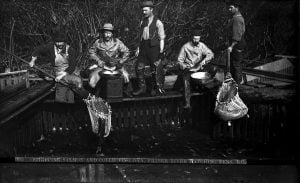
History
The hatchery crutch: How we got here
From their beginnings in the late 19th century, salmon hatcheries have gone from cure to band-aid to crutch. Now, we can’t live without manufactured fish.
- 4255 words
- 18 minutes
This article is over 5 years old and may contain outdated information.
Environment

The Nature Conservancy of Canada has protected more than 800 hectares of forested land adjacent to New Brunswick’s Bartholomew River, an important spawning ground for at-risk Atlantic salmon.
The acquisition represents the largest private-land conservation project in the province’s history and creates a continuous corridor of protected land between two tributaries of the Miramichi River, one of the biggest producers of wild Atlantic salmon in North America.
Atlantic salmon numbers have been in steep decline in Canada since the 1990s, with 2014 described as a “crisis year” by the Atlantic Salmon Federation.
“The big concerns with Atlantic salmon tend to be more about international fishing and survival at sea, but within our watersheds in New Brunswick we have significant and healthy salmon runs,” said Paula Noel, program director for the NCC in New Brunswick.
“We need to make sure we’re doing all we can to protect the integrity and health of the spawning grounds.”
The new protected area includes five kilometres of waterfront along the Bartholomew, within which are found two deep cold-water pools — an important rest stop for salmon as they make their way upriver to spawn.
The NCC also identified three at-risk bird species — the eastern wood pewee, common nighthawk and rusty blackbird — nesting on the property, as well as habitat supporting moose, black bears, coyotes, weasels, beavers, snowshoe hares and a variety of amphibians and waterfowl.
“There’s so much diversity and so many different habitat types within the area,” Noel said. “Our goal for the reserve is to manage it and ensure all the species it supports continue to thrive.”
The protected area will be named the Foxner Reserve in honour of the Fox and Faulkner families, who donated the land to the NCC through the Government of Canada’s Ecological Gifts Program.
Are you passionate about Canadian geography?
You can support Canadian Geographic in 3 ways:

History
From their beginnings in the late 19th century, salmon hatcheries have gone from cure to band-aid to crutch. Now, we can’t live without manufactured fish.

Environment
Struggle and success in Atlantic Canada, where aquaculturists strive to overcome climate change and contamination while chasing a sustainable carbon footprint

Wildlife
Salmon runs are failing and grizzlies seem to be on the move in the islands between mainland B.C. and northern Vancouver Island. What’s going on in the Broughton Archipelago?

Wildlife
“We just knew no fish would get by. Not without our help.” Behind the scenes of the epic campaign to save a Fraser River salmon run.